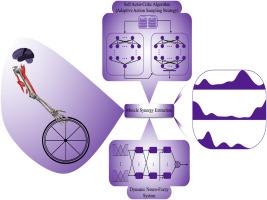Physiologically constrained neuromuscular synergy extraction using a deep off-policy dynamic neuro-fuzzy system in wheelchair propulsion
IF 6.3
2区 医学
Q1 BIOLOGY
引用次数: 0
Abstract
Manual wheelchair propulsion (MWP) is a repetitive activity that risks upper limb injuries, necessitating analysis of intramuscular coordination for effective intervention. The state-of-the-art synergy extraction methods struggle with MWP's nonlinear, dynamic nature and often overlook biomechanical constraints. This study introduces a deep reinforcement learning-based dynamic neuro-fuzzy (DRL-DNF) system that models complex electromyography (EMG) patterns and refines synergy structures in real time. Data from 24 manual wheelchair users included EMG signals from six muscles, joint kinematics, and handrim force. A musculoskeletal model was incorporated to account for joint dynamics and external forces, ensuring physiologically meaningful synergy extraction. Statistical analysis showed that DRL-DNF outperformed conventional methods, achieving a mean variance accounted for (VAF) of 94.12 ± 4.12 % in noise-free and 90.1 ± 4.18 % in noise-presence for three synergies, indicating strong robustness to noise and superior modeling of agonist-antagonist interactions. Significant differences in third synergy activations revealed autoencoder (AE) had higher values than independent component analysis (ICA) and non-negative matrix factorization (NMF), while ICA had lower values than NMF and DRL-DNF. Statistical parametric mapping indicated temporal differences, with ICA underactivating during the push and recovery phases, and AE overactivating in late recovery phase. Synergy coefficients also differed significantly across methods. AE consistently assigned lower weights to biarticular muscles, while NMF emphasized shoulder flexors and DRL-DNF provided a balanced representation. DRL-DNF identified physiologically relevant synergies, enhancing insights into intramuscular coordination strategies and showing potential for synergy-based control in assistive devices and rehabilitation. Future work will aim to enhance computational efficiency and expand dataset diversity for real-time application.

基于深度非策略动态神经模糊系统的轮椅推进生理约束神经肌肉协同提取。
手动轮椅推进(MWP)是一种有上肢损伤风险的重复性活动,需要分析肌肉内协调以进行有效干预。最先进的协同提取方法与MWP的非线性、动态特性作斗争,并且经常忽略生物力学约束。本研究介绍了一种基于深度强化学习的动态神经模糊(DRL-DNF)系统,该系统模拟复杂的肌电图(EMG)模式并实时细化协同结构。来自24位轮椅使用者的数据包括六块肌肉的肌电信号、关节运动学和手环力。一个肌肉骨骼模型被纳入考虑关节动力学和外力,确保生理上有意义的协同提取。统计分析表明,DRL-DNF优于传统方法,在无噪声和有噪声情况下,三种协同效应的平均方差占比(VAF)分别为94.12±4.12%和90.1±4.18%,表明对噪声具有较强的鲁棒性和对激动剂-拮抗剂相互作用的良好建模。第三协同激活的显著性差异表明,自编码器(AE)的激活值高于独立成分分析(ICA)和非负矩阵分解(NMF),而ICA的激活值低于NMF和DRL-DNF。统计参数映射显示了时间上的差异,在推送和恢复阶段,ICA激活不足,而在恢复后期,AE激活过度。不同方法的协同系数也存在显著差异。AE始终将较低的重量分配给双关节肌肉,而NMF强调肩屈肌和DRL-DNF提供平衡的表现。DRL-DNF确定了生理上相关的协同作用,增强了对肌肉内协调策略的认识,并显示了在辅助装置和康复中基于协同控制的潜力。未来的工作将致力于提高计算效率,扩大数据集的多样性,以实现实时应用。
本文章由计算机程序翻译,如有差异,请以英文原文为准。
求助全文
约1分钟内获得全文
求助全文
来源期刊

Computers in biology and medicine
工程技术-工程:生物医学
CiteScore
11.70
自引率
10.40%
发文量
1086
审稿时长
74 days
期刊介绍:
Computers in Biology and Medicine is an international forum for sharing groundbreaking advancements in the use of computers in bioscience and medicine. This journal serves as a medium for communicating essential research, instruction, ideas, and information regarding the rapidly evolving field of computer applications in these domains. By encouraging the exchange of knowledge, we aim to facilitate progress and innovation in the utilization of computers in biology and medicine.
 求助内容:
求助内容: 应助结果提醒方式:
应助结果提醒方式:


